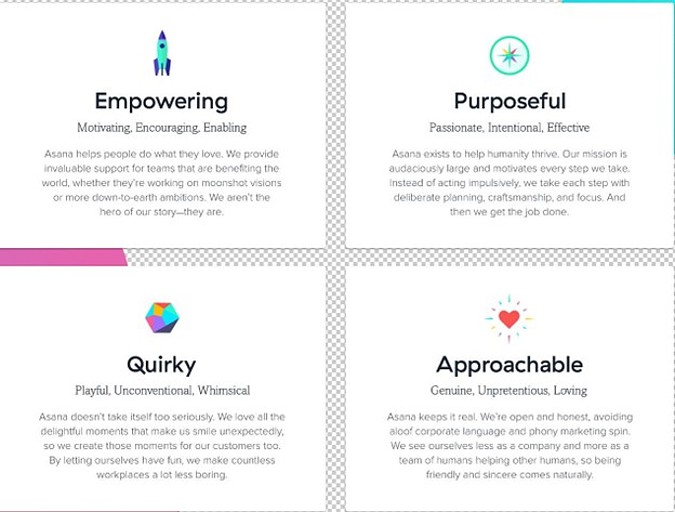Your brand needs a style guide to ensure that everyone who posts on your social media platforms speaks in one voice and tone. A social media style guide will help ensure your audiences recognize your brand, regardless of the social media platform they go to. It also helps ensure brand recall, which may, in turn, translate into conversions.
But how do you create a social media style guide in the first place?
Here's how—in five simple steps.
1. Define your brand voice
Your company voice defines the way your brand talks to its audience. That voice should stay consistent across different posts and platforms. For instance, if your brand voice is "friendly," then all your content should use that voice.
On the other hand, tone refers to using the brajd voice to convey different meanings. A friendly voice, for example, can be happy when celebrating a milestone, or it can be inviting when promoting a new product.
The Content Marketing Institute recommends that you define your brand's voice in three simple words. Take a look at how Asana does that in four words:

Source: Emplifi
Getting the 3-4 words to be cohesive is more complicated than it looks; it will require some trial and error. After all, we're choosing adjectives, and there are thousands of adjectives in the dictionary, each with its own set of nuances.
To determine your three words, I suggest looking at your target audience first. What are the values that resonate the most with them? Aligning your brand voice with your target audience's core values will help with building your brand.
2. Define your formatting guidelines
Each social network has its own unique formatting conventions. For example, Twitter has a 280-character limit. Most social media experts recommend keeping Facebook updates and captions to below 60 characters.
Also, different networks specify different image and video sizes. Your social media style guide should include such conventions.
Here are some formatting guidelines your brand can follow:
- Keep copy short, and use the first sentence to get to the point.
- Limit text to three sentences.
- Shorten the links in the post using a URL shortener, such as Bitly.
- Ensure that hashtags and mentions are contextually relevant. Also, 2-4 hashtags are sufficient for most platforms—except Instagram, where you can use more.
- Add a high-quality image relevant to the post.
Here's an example from Kyndryl:

Source: @Kyndryl
If you scroll down Kyndryl's Twitter feed, the company's tweets are similar to that one in color, template used, and tone of voice. So, when audiences see the tweets, they automatically recognize Kyndryl even without looking at the Twitter account name.
3. Create media guidelines
Your social media style guide should cover the types of media you will use in your content and posts. That includes guidelines on images, videos, infographics, and audio. The line between what's allowed and what isn't should be clearly defined.
For example, you can say it's OK to post a cartoon, but anything that makes fun of gender, social, or race differences isn't OK.
You can start with the following guidelines and then build on them as you go along:
- Spell out the media size appropriate for each platform.
- Define a consistent color scheme for your posts.
- Aim for inclusivity and diversity when you post photographs of people.
- Avoid using stock photos.
If you clearly define the media guidelines in your social media style guide and implement them consistently, don't be surprised if you find your audience responding in the same voice and tone. That's a sign of scoring a win.
4. Align your social media accounts
Audit all your company's social media profiles to check how many profiles you're running. Keep in mind that the viewer looking at your account on Facebook probably also visits you on Instagram. Maintaining a consistent profile across social media platforms and other locations helps users recognize your brand and engage with it more efficiently.
Of course, there are exceptions to this rule if you are a large global brand with multiple products, and each product has a unique customer base.
For instance, IBM has several verified accounts on Instagram, each starting with the word "IBM." Some accounts focus on specific products, whereas others focus on different audiences. @IBMcloud focuses on cloud technology; @IBMDeveloper focuses on the developer community.

Source: Emplifi
Even with multiple accounts, notice how some things—such as the iconic eight-bar logo and blue color palette—remain consistent.
5. Develop a response playbook for all situations
A response playbook in your social media style guide defines how your brand responds to comments from your customers. For example, do you ignore negative comments, or do you view them as an opportunity to resolve them and build your brand's credibility?
Your responses to such situations should be closely aligned with your brand voice. In some cases, your social media team may also be required to respond to private messages. Sometimes even a chatbot can escalate a conversion to your social team.
Inform your social media team about the need to stick to your brand's core values when responding to comments; if they do, you'll avoid social media mistakes, and you'll be fine.
* * *
You need a social media style guide to maintain consistency in your posts across platforms, ensuring your audience will recognize and recall your brand by just viewing your posts, which may translate into conversions.
The steps in this article will help you create a social media style guide. Define your brand voice and your formatting guidelines. Make sure your media guidelines are specified, too, and your social media accounts are aligned. And you should have a response playbook for all situations.
A final tip: keep in mind that your style guide is an evolving document. That means it should adapt to the changing preferences of your audience.
More Resources on Style Guides and Social Media
On Social Media, a Little Brand Personality Goes a Long Way
How to Implement a Content Style Guide
Every Brand Needs a Distinct Tone of Voice. Here's Why—and How to Create It




